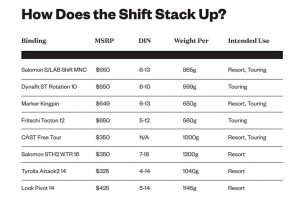The Binding of the Year
A new standard is set for alpine bindings and touring compatibility.
The Salomon Shift binding is POWDER’s Binding of the Year, as seen in the September Buyer’s Guide issue on newsstands. The following is our complete review. To see how it compares to other bindings on the market, see the chart below or read our reviews here.
SALOMON
Shift
Every once in a while, a product comes along and forever alters the way things are done. Like in 1926, when Austrian mountaineer Rudolf Lettner invented skis with steel edges so he could have better grip.
And in 1947, when Howard Head, an aircraft engineer who was unsatisfied with the heavy, inflexible wood skis of the day, spent $250 on a band saw and built the first metal skis, bonding a plywood core between sheets of aluminum and sidewalls.
In 1996, Shane McConkey dreamed up the first skis with reverse sidecut and reverse camber, which evolved into rocker, a concept that's present across nearly all categories of skis.
Whether it's using a new technology, materials, or design, these products changed the way we approach the mountains. This year, we are focusing on a binding from Salomon, whose history goes back to 1966 when the French company released the first binding with a self-release heel piece.
Like that original clamp, the problem the new Salomon S/LAB Shift MNC attempts to solve is safety. It combines a tech binding's ease of uphill travel with an alpine binding's security and release on the downhill. It has pins for touring, but it is also multi-norm compatible and has a DIN certification of 6-13.
This means you no longer have to debate whether to lock your tech bindings before skiing something steep and exposed. It means you don't have to lug heavy-ass frame bindings up thousands of vertical feet, thereby saving energy for the descent.
It means that when you travel and think you might ski tour one day but will mostly be inbounds, you only need to bring one pair of skis--your favorite pair of skis. And, with Multi-Norm compatibility, the Shift is easily adjustable to most boot sole types (with a few exceptions; check with your local ski shop).
All you need is a screwdriver to lower or raise the height of the anti-friction device (AFD) on the toe.
Where the Shift really shines is where it matters most: how it skis. In a range of conditions, the binding's responsiveness, agility, maneuverability, and feel is remarkable.
Compared to OG frame bindings (like the Marker Duke or Salomon Guardian), it's a feather. Though it outweighs tech bindings by a few hundred grams, you will likely only notice the difference on epic slogs.
When I stepped in, I was as close to the ski as I would be in Salomon's cult-classic alpine binding, the STH. Thanks to wings in the toe piece that are reminiscent of the STH, I leaned into turns with as much weight as I could. I sped down groomers and cut up bumps, never compromising my skiing.
Due to its low weight, I had initially thought of it as a touring binding with the versatility to ski in the resort, like the Marker Kingpin or Dynafit Beast. But I soon realized I had it the wrong way. The Shift is an alpine binding for resort skiing that has a lever you flip to take it on a tour.
A traditional tech binding is still the best option if you are looking to do faraway missions on a lightweight setup. When in tour mode on the Shift, the angle of the heel is never flat, but rather at two degrees.
That may bother some people, but I only noticed it on long, flat stretches. There is also only one climbing aid, at 10 degrees, and I'd prefer having two options, a medium and tall height, to adjust depending on the steepness of the skin track.
Salomon's thought is that a skin track requiring any more heel lift than 10 degrees is, well, too steep. (Atomic, owned by the same parent company, carries the binding as well and brands it under the same Shift name.)
It will take some practice before you memorize the system to transition between ski and tour mode without hesitation. There is one lever on the toe piece that you have to flip, and another on the heel piece that also snaps up the brake.
A couple times over the winter, I accidentally clipped the brake on the opposite ski, which caused it to drag, and then I had to take the ski off to reset the heel and the brake before I could continue.
Additionally, the heel piece has a strong spring, which requires a concentrated effort to step into and engage. I skied the Shift all season long--in British Columbia, the Sierra Nevada, and Utah--on long tours and side trips from the resort, to groomer laps and slush bumps on spring days.
My criticisms were minimal. My gratitude for what this binding is to my skiing moving forward was plenty, as the Shift sets a new standard for alpine bindings and touring compatibility.
Credit:
Powder Magazine
By Julie Brown





